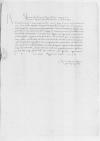List #2133
Sigismund I Jagiellon do Ioannes DANTISCUSCracow (Kraków), 1539-04-13
| odebrano [1539]-04-26 Rękopiśmienne podstawy źródłowe:
Pomocnicze podstawy źródłowe:
| ||||||||||
Tekst + aparat krytyczny + komentarz Zwykły tekst Tekst + komentarz Tekst + aparat krytyczny Ekscerpty dotyczące podróży Dantyszka
Reverendo in Christo Patri, domino
Reverende in Christo Pater, sincere nobis dilecte.
Cum et
Dat(um) or Dat(ae)⌈Dat(um)Dat(um) or Dat(ae)⌉
Ad mandatum regiae maiestatis proprium


 BNW, BOZ 953, f. 171v.
BNW, BOZ 953, f. 171v.